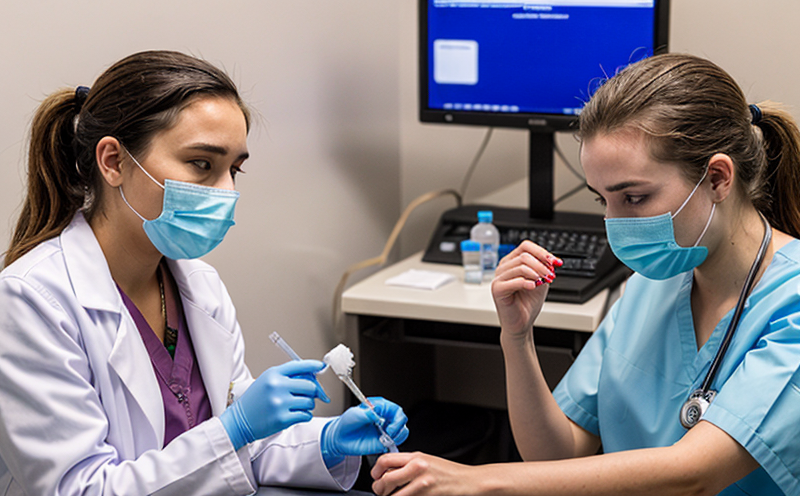ASTM E3206 Detection of Resistant Bacteria in Clinical Samples
The ASTM E3206 standard provides a comprehensive protocol for detecting resistant bacteria in clinical samples, an essential process to ensure the effectiveness of antimicrobial therapy. This method is widely used in healthcare settings where precision and accuracy are paramount to patient safety and treatment efficacy.
Resistant bacteria pose significant challenges to modern medicine, as they can lead to infections that are difficult or impossible to treat with conventional antibiotics. By detecting these resistant strains early, healthcare providers can tailor treatments more effectively, potentially saving lives and reducing the spread of infection within hospitals.
The ASTM E3206 method is designed for laboratories equipped with advanced microbiological facilities. It involves several key steps: sampling, sample preparation, inoculation onto selective media, incubation, and interpretation of results based on specific criteria outlined in the standard. This process ensures that laboratories can reliably identify resistant bacteria strains.
The standard emphasizes the importance of using high-quality reagents and equipment to ensure accurate results. It also stresses the need for strict quality control measures throughout the testing process to minimize errors and ensure reproducibility.
Understanding the principles behind ASTM E3206 helps stakeholders appreciate its significance in clinical microbiology. This method is crucial not only for diagnosing infections but also for monitoring the effectiveness of treatment regimens, thereby enhancing patient care and public health outcomes.
Scope and Methodology
The ASTM E3206 standard covers a wide range of aspects related to detecting resistant bacteria in clinical samples. It specifies the procedures for collecting, processing, and analyzing samples from patients suspected of having infections caused by resistant bacteria.
| Aspect | Description |
|---|---|
| Sample Collection | Involves swabs, aspirates, or other materials collected directly from the patient. Samples must be aseptically handled to prevent contamination. |
| Preparation | Includes dilution of samples and inoculation onto selective media designed to enhance the growth of resistant bacteria. |
| Inoculation | Bacteria are grown on specialized agar plates that promote the growth of resistant strains over other types. |
| Incubation | The plates are incubated under controlled conditions conducive to bacterial growth, typically at 35°C for 48 hours. |
| Identification and Interpretation | This involves visual inspection of the plates to identify colonies indicative of resistant bacteria. Results are compared against criteria in ASTM E3206 to determine if resistance is present. |
The standard also provides guidelines for reporting results, which include details about the patient, sample type, and specific strains detected. This ensures that healthcare providers have accurate and actionable information at their disposal.
Customer Impact and Satisfaction
The implementation of ASTM E3206 has a profound impact on both clinical practice and patient outcomes. By detecting resistant bacteria early, laboratories can provide timely feedback to healthcare providers, enabling them to adjust treatment strategies promptly.
- Precision in Diagnostics: Accurate identification of resistant bacteria allows for more effective use of antibiotics, reducing the risk of side effects and promoting better health outcomes.
- Informed Decision-Making: Results from ASTM E3206 help clinicians make informed decisions about patient care, leading to improved treatment efficacy and reduced hospital stays.
- Patient Safety: Early detection of resistant strains minimizes the risk of spreading infections within healthcare facilities. This is particularly important in environments like hospitals where cross-infections can have severe consequences.
Customer satisfaction with the ASTM E3206 method is high, as it demonstrates a commitment to quality and safety. Laboratories that adopt this standard are better positioned to meet regulatory requirements and enhance their reputation among healthcare providers and patients alike.
Use Cases and Application Examples
- Hospital Infections: Detecting resistant bacteria in patients with suspected infections helps prevent the spread of these strains within hospitals.
- Treatment Monitoring: Regular testing can monitor the effectiveness of antibiotic regimens, allowing for adjustments if resistance is detected.
- New Drug Development: Researchers use ASTM E3206 to test new antibiotics against resistant bacteria strains, ensuring that these drugs are effective when introduced into clinical practice.
- Public Health Surveillance: Laboratories involved in public health monitoring use this method to track the prevalence and spread of resistant bacteria in communities.
In each case, ASTM E3206 plays a crucial role in ensuring that healthcare providers have the information they need to deliver optimal care. This standard is particularly valuable for laboratories focused on clinical microbiology testing, as it provides a robust framework for detecting resistant bacteria effectively and reliably.





